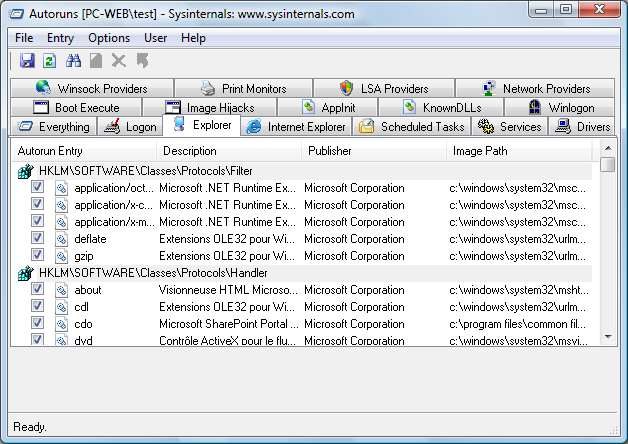Sysinternals, poorly known Windows tools
It is not known that Microsoft provides a set of tools for checking or obtaining information about Windows.
Most of them are planned for XP and subsequent versions, some of them also work on older versions. Here is a selection of those that seemed most useful to me.
For the office
 BgInfo
BgInfo
Displaying system information in the background of the desktop: free disk space, processor use, etc. It consumes few resources. The image on the right contains only a small part of the information that can be displayed.
ZoomIt
Magnifying glass. Use begins with setting up function keys.
Autons
Graphical interface for configuring programs that run when Windows starts.

Programming assistance
DebugView
Displays debug information on the local computer or on the network. Schedule and all systems.
Hex2dec
Converts hexadecimal numbers to decimal numbers.
System Security Resources
AccessChk
Indicates which resources (files, etc.) are accessed.
AccessEnum
Specifies who (administrator, user) has access to directories and registry content. Plot.
RootkitRevialer
Detects viruses in the registry.
SDelete
Security delete erases files so that they cannot be retrieved or seen using hard drive analysis.
System and File Information
Diskmon
Displays hard drive activity.
DiskView
Graphically displays the location of files on your hard drive.
Displays the number of files and occupied space for a specific directory.
Say
Specifies which files are used by such a program, which processes are open.
NtfsInfo
Information about the NTFS volume, including where the file table is located and how it is stored.
ProcessExplorer
A graphical interface designed to display current processes and system activity.
ProcessMonitor
Combines several previous system programs into one interface and works on all modern versions of Windows. It displays current processes and software and helps track malicious activity.
It allows you to edit the registry and replaces the rule.
ProcFeatures
Displays the name and features of the processor, such as 3D Now, SSE...
TomId
Changes the FAT or NTFS volume ID (while the label changes the name). Visible after system reboot.
WinObj
Manage objects for administrators.
Change the contents of files
Thongs
Converts files with unreadable Unicode for text editors.
Synchronization
Empties buffers and finishes writing files to safely remove the removable device.
System and LAN management
These tools are local by default, but you can specify a remote Windows system. Therefore, they do not work on a Linux server.
Portmon
Serial and parallel port management.
PsExec
Replace Telnet to perform procedures on the remote computer.
PsFile
Shows open remote files and allows you to close them.
PsInfo
Provides information about your local or remote Windows system.
PsPasswd
Changing password.
PsShutdown
Shut down or restart your computer.
Information about networks, including the Internet
ShareEnum
Discover user domains for shared files.
TcpView
Displays current connections and closes them.
Quis
Displays whois for a domain name or IP address. It is better to use this command before booking a domain name than to go through the registrar's online service, because these actions leave traces and the domain can be reserved by someone else. Sometimes the registrar himself, who then offers to resell it at a higher price, is charged, in particular, GoDaddy.
Other tools
Other tools that have more specialized uses are also included. Programs that can only be used on older versions of Windows or that only work on the server version are not described.
- Sysinternals
Download tools and documentation in CHM format. - Presentation.